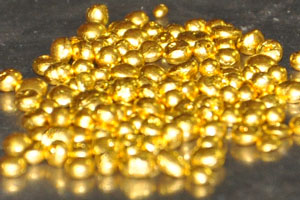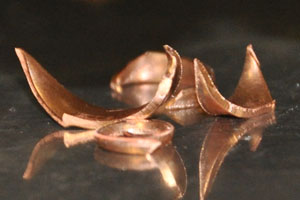
| MAKE YOUR OWN | PHOTOS | TESTIMONIALS | PRICING | CONTACT | |


gold and copper alloyed together will create these red gold hammered bands
Gold - gold's rich color and malleability have made it the metal of choice for thousands of years. We can make rings in yellow, red, pink, white, green, and peach golds. Multiple colors can be used to create multi-colored wedding rings. I recommend 18k gold for most purposes. Higher karats such as 22k or 24k have a beautiful rich yellow color and are very fun to work with. The down side is they scratch more and are expensive. 14k is often harder, less expensive, and more scratch resistant. It is more difficult to work and is not as colorful. A lot of people have misconceptions about white gold. There are MANY alloys of gold created for specific purposes. The white gold we use in our workshops is alloyed with palladium - hence it is hypoallergenic and does not require plating. Almost all the gold we use in our studio is 100% recycled eco-gold. Platinum - platinum has become much more popular in the last decade. Like gold it is hypo-allergenic. It has a rich grayish sheen for those who do not like gold rings. It is strong, scratch resistant and luciously heavy. Platinum's drawbacks are that the hardness makes it more difficult to work with and it is expensive. Some platinum jewelry sold in stores is rhodium-plated to make it white and shiny. These rings must be re-plated regularly to keep them looking good. I do not plate platinum. Palladium - palladium is in the platinum family of metals and is a similarly colored, less dense, and less expensive alternative to platinum. Palladium rings were fabricated 60 years ago when platinum was temporarily banned for jewelry use in the United States to support the war effort. Palladium is also commonly alloyed with gold to make high-quality white gold. It is strong and holds a good polish. Like platinum, palladium's strength makes it more difficult than gold to work with. Palladium is currently less expensive than gold or platinum. I encourage anyone on a budget to use palladium instead of platinum for rings. Although it is not commonly used, it is an excellent jewelry material. Mokume Gane - The Japanese technique of merging precious metals and twisting them into a wood grain-like pattern offers a unique alternative look to what is commonly used in jewelry. A mokume wedding band is sure to elicit questions and compliment from many. It is expensive. Silver - silver takes on beautiful finishes and can be used to accentuate rings. I generally recommend, however, that different shades of gold be used instead of silver, copper, brass, and bronze. Most of the cost of your rings will be labor, so spending a little extra on materials will not significantly change the total price. Silver is a good choice of metal for custom bridesmaids' gifts. Electrum - electrum is a mixture of 50/50 gold and silver. It is pale yellow and soft. It is not often used in jewelry today. Catchy name, though. We can make electrum in my studio. Stainless Steel - a variety of non-precious metals have become popular in wedding rings as of late, including steel, titanium, and tungsten carbide. All three of these are very hard, scratch-resistant metals. Of these metals, we can make rings out of stainless steel or titanium. Unless you have a specific reason for wanting stainess steel or titanium wedding rings, I recommend precious metal. Other - other materials can be incorporated into jewelry if desired. These include: stone, enamel, wood, bone, resin. If there is anything not listed on this page that you want to use, give us a ring! Cheers! Learn more about Wedding Ring Workshops by Sam Abbay: |
wedding ring photos | engagement ring photos | workshop photos | contact
new york wedding ring | materials | diamond | prices | testimonials | home
© 2018 Sam Abbay